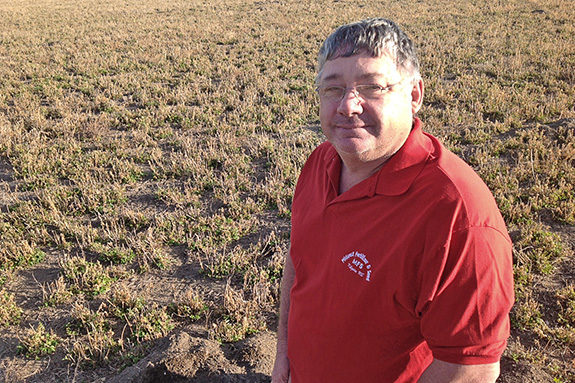All that changed last year when he discovered a new type of bait that he claims has given him the best gopher control he’s ever experienced.
Ten years ago, Dr. Greathouse moved to his current ranch in Bryan, Texas, where he runs a cow-calf beef operation with hundreds of acres of pasture and hay.
Since he began, pocket gophers were a tremendous problem, especially in and near the hayfields.
A lot of damage was done to harvesting equipment from cutting through gopher mounds, slowing harvest and adding repair costs, in addition to reducing alfalfa grade from dirt in the bales.
For years he battled the pocket gophers utilizing a burrow-builder machine and strychnine bait, treating once a year in the spring.
He was constantly challenged with the strychnine clumping and balling up in the burrow-builder. There were certain times of the year, when grass and hay were green, when bait acceptance and control with strychnine was poor.
Frustrated, Dr. Greathouse knew there had to be a better way, “You’re going to have a real problem being productive in Texas if you don’t effectively manage pocket gophers.”
He decided to try a new type of bait – one made with chlorophacinone, a strychnine substitute.
Chlorophacinone is an anticoagulant; it interferes with blood clotting. It is considered a more advanced means of gopher control due to its non-target profile.
Anticoagulants are easy to use (no pre-baiting), easy to store and can be used season-long. Anticoagulants such as chlorophacinone only carry a “Caution” label, requiring minimum personal protective equipment (gloves), and have a readily available antidote.
In contrast, strychnine requires users to wear waterproof gloves, safety goggles and a dust-filtering respirator. Older technologies like strychnine carry a Danger (skull and crossbones) label and have a high primary toxicity to humans and wildlife – a concern for many landowners and their employees, particularly when pets, livestock or non-targets are present.
Both strychnine and zinc phosphide (ZP) need pre-baiting with untreated grain to improve gopher acceptance and control, doubling labor costs and delaying control until after more damage may have occurred.
This has led growers to often only bait during the dormant or winter season to effectively force rodents to accept these less-palatable baits. In comparison, chlorophacinone is more palatable and highly accepted by pocket gophers.
Because chlorophacinone formulations are so palatable and moisture-resistant, Dr. Greathouse is able to do more frequent preventative treatments when sufficient soil moisture permits the formation of good artificial burrows.
He can address problem areas after cuttings – as soon as he sees them. He can also make follow-up treatments during the wet fall, and again treat fields in the spring, even when grass or forage are green, giving him more management options resulting in better control.
One ag-chemical distributor that has habitually seen high pocket gopher infestation is Tom Schneider of Midwest Fertilizer in Kilgore, Nebraska.
“In the past, I used to sell a lot of strychnine, but as more growers tried anticoagulant-based baits gopher control has been more successful. Using chlorophacinone, growers are able to treat for gophers multiple times a year, preventing them from becoming a huge problem. I’ve never had a customer return to strychnine after upgrading to an anticoagulant.”
While Dr. Greathouse was initially hesitant to change his methods, he’s thankful he did.
“It’s the best control I’ve ever experienced, and the results have been long lasting,” he says. He recommends that other growers embrace new technology to solve old problems; it’s been a game changer in the battle against pocket gophers.
Ted Bruesch
Technical Services Manager
Liphatech Inc.
PHOTO
Tom Schneider in Kilgore, Nebraska, investigates a gopher population in an alfalfa stand. Schneider has seen an up-swing in chlorophacinone sales to producers to help control gopher populations in hay fields. Photo by Ted Bruesch.









